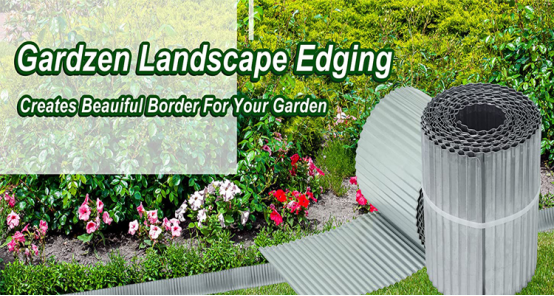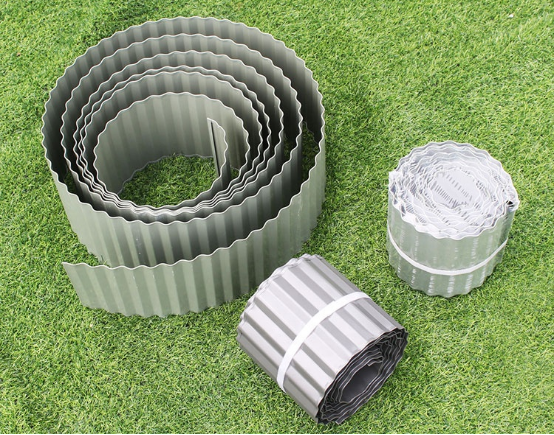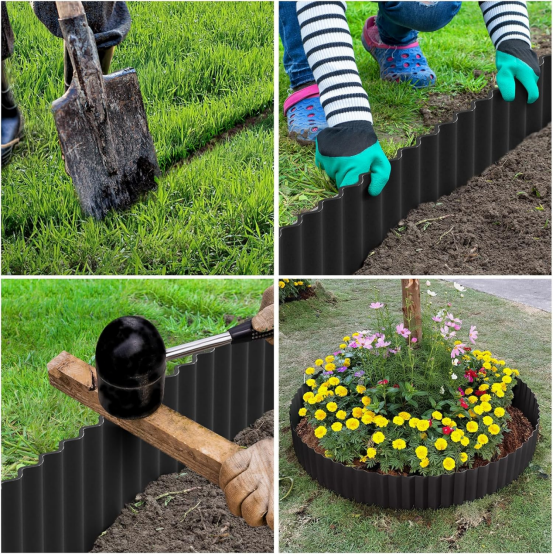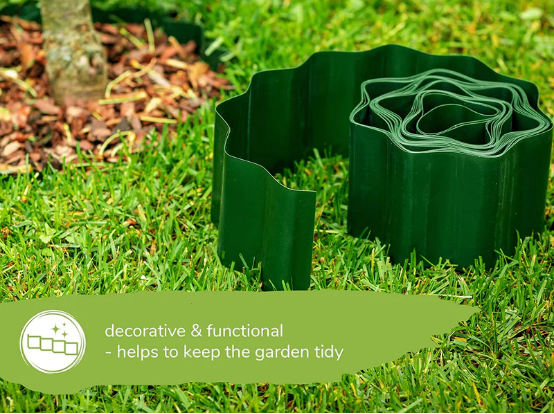
Home & Garden Sundries Supplier
MIF+Garden, Your Bridge To Happy Life- contact us james.li@mif-garden.com
- call us anytime
0086-750-3328199
0086-18923082686

Pubdate: 2024-04-07
From Function to Design Exploring the Possibilities of Corrugated Garden Edging

Corrugated Garden Edging refers to a type of garden edging that is made from corrugated metal sheets. These metal sheets are typically formed with alternating ridges and grooves, creating a corrugated or wavy pattern along the length of the material. Corrugated garden edging is commonly used to create borders or boundaries between different areas in a garden or landscape.
The composition of corrugated garden edging typically includes the following components:
Corrugated Metal Sheets: Corrugated garden edging is primarily made from corrugated metal sheets. These sheets are commonly manufactured using materials like galvanized steel or other corrosion-resistant and weather-resistant materials, providing high strength and durability.
Edge Connectors: Each section of corrugated garden edging usually comes with edge connectors to join the edge panels together. These connectors are typically located on one side of the edge panels and are inserted into the grooves of adjacent panels for secure connections.
Anchoring Devices: Anchoring devices are often required to secure the corrugated garden edging in place. These devices can be ground stakes or anchor rods used to fasten the edge panels to the ground, ensuring stability and firmness of the edging.
Decorative Elements: Some corrugated garden edging may feature decorative elements such as patterns, designs, or decorative edge profiles. These decorative elements enhance the aesthetics of the edging and coordinate with the overall garden style.
Optional Components: Depending on individual needs and design requirements, corrugated garden edging may also include optional components such as connectors, corner pieces, or curved sections to meet specific installation and design needs.
It's important to note that the composition of corrugated garden edging may vary depending on the manufacturer and product type. The specific components may differ, so it's advisable to carefully read the product instructions and follow the manufacturer's guidelines when selecting and installing corrugated garden edging.
Here are the steps to install corrugated garden edging:
Prepare tools and materials: Ensure you have the following tools and materials: corrugated garden edging, hammer, ground stakes or anchor rods, measuring tool (such as a ruler or measuring tape), lawn trimmer or hoe, safety gloves, and goggles.
Clear the boundary area: Clear the area along the garden boundary, ensuring it is smooth, clean, and free from any weeds or obstacles. If needed, trim the lawn or dig the soil to ensure a level boundary line.
Measure and mark: Use the measuring tool to measure the length of the edging you want to install and mark the position of the edging on the ground. Ensure the marking lines are straight and accurate.
Install the edging panels: Insert the first piece of corrugated garden edging into the ground, aligning the edge connector with the groove of the next panel to securely connect them. Continue installing the other edging panels along the marked line until the desired length is achieved.
Anchor the edging: To secure the edging, use a hammer to insert ground stakes or anchor rods into the holes of the edging panels. Distribute the anchoring devices evenly along the edging, as needed, to ensure stability.
Adjust and trim: Ensure the edging panels are installed straight and make any necessary adjustments. Use a lawn trimmer or hoe to trim the soil around the edge line and ensure the edging is level with the ground.
Clean up and maintenance: Clear any weeds and debris around the installed corrugated garden edging. Regularly inspect the stability of the edging and perform maintenance and repairs as needed.
Please note that the above steps are general guidelines, and specific installation steps may vary depending on the type of product and manufacturer recommendations. Before installing corrugated garden edging, it is advisable to carefully read the product instructions and follow the guidance and recommendations provided by the manufacturer.

Here are the steps to install corrugated garden edging:
Prepare tools and materials: Ensure you have the following tools and materials: corrugated garden edging, hammer, ground stakes or anchor rods, measuring tool (such as a ruler or measuring tape), lawn trimmer or hoe, safety gloves, and goggles.
Clear the boundary area: Clear the area along the garden boundary, ensuring it is smooth, clean, and free from any weeds or obstacles. If needed, trim the lawn or dig the soil to ensure a level boundary line.
Measure and mark: Use the measuring tool to measure the length of the edging you want to install and mark the position of the edging on the ground. Ensure the marking lines are straight and accurate.
Install the edging panels: Insert the first piece of corrugated garden edging into the ground, aligning the edge connector with the groove of the next panel to securely connect them. Continue installing the other edging panels along the marked line until the desired length is achieved.
Anchor the edging: To secure the edging, use a hammer to insert ground stakes or anchor rods into the holes of the edging panels. Distribute the anchoring devices evenly along the edging, as needed, to ensure stability.
Adjust and trim: Ensure the edging panels are installed straight and make any necessary adjustments. Use a lawn trimmer or hoe to trim the soil around the edge line and ensure the edging is level with the ground.
Clean up and maintenance: Clear any weeds and debris around the installed corrugated garden edging. Regularly inspect the stability of the edging and perform maintenance and repairs as needed.
Please note that the above steps are general guidelines, and specific installation steps may vary depending on the type of product and manufacturer recommendations. Before installing corrugated garden edging, it is advisable to carefully read the product instructions and follow the guidance and recommendations provided by the manufacturer.

Corrugated garden edging can be classified according to different criteria. Here are several common classification methods:
Material classification: Corrugated garden edging can be classified based on the materials used in their manufacturing. Common materials include galvanized steel, aluminum alloy, plastic, and wood. Different materials have different characteristics and purposes, and you can choose the appropriate material based on personal preferences and project requirements.
Height classification: Corrugated garden edging can be classified based on their height. Generally, the height of the edging can be selected according to specific needs, with common options including 4 inches, 6 inches, and 8 inches. Taller edging provides better boundary definition and protection.
Color classification: Corrugated garden edging can also be classified based on their color. Common colors include black, silver, green, and brown. Choosing the right color can coordinate with the overall style and landscape of the garden.
Shape classification: Corrugated garden edging can be classified based on their shape. In addition to straight-line edging, there are options available for curved or customizable shapes, such as curved edging, corner pieces, and circular edging.
When it comes to the detailed maintenance of corrugated garden edging, here are some suggestions and methods:
1.Cleaning:
Clean the corrugated garden edging using a mixture of water and mild detergent. Avoid using overly strong cleaning agents that may damage the surface of the edging.
Use a brush or soft cloth to clean the surface of the edging. Pay particular attention to the grooves and ridges between the edging panels to ensure thorough removal of dust and dirt.
Clear any weeds and debris around the edging to maintain a neat appearance.
2.Inspection and repair:
Regularly inspect the stability and integrity of the corrugated garden edging. Check for any loose or damaged edging panels and connecting components.
If you find any loose edging panels, gently tap them back into place using a rubber mallet.
For damaged or severely rusted sections, consider replacing the affected edging panels or anchoring devices.
3.Preventing water accumulation:
Ensure that there is no water accumulation around the corrugated garden edging. Standing water can lead to corrosion or damage to the edging and may have adverse effects on the garden plants.
Check the drainage situation around the edging. If there are issues with water pooling, take measures to improve drainage, such as digging drainage ditches or installing drainage pipes.
4.Avoid heavy pressure:
Avoid placing heavy equipment, vehicles, or large objects on the corrugated garden edging to prevent damage to its structure.
If there is a need to pass through the edging area, consider adding additional support or setting up warning signs to remind people to avoid stepping on or exerting pressure on the edging.
5.Replenish coatings (if applicable):
Some corrugated garden edging may have protective coatings such as galvanization or specialized coatings.
Regularly check the coatings for signs of wear or corrosion. If issues are found, consider recoating with a protective layer to extend the lifespan and appearance of the edging.
In summary, regular cleaning, inspection and repair, prevention of water accumulation, avoidance of heavy pressure, and replenishing coatings (if applicable) are key steps in maintaining corrugated garden edging. Specific maintenance requirements may vary depending on the edging material and manufacturer's recommendations. Please refer to the product instructions and manufacturer's provided maintenance guidelines to ensure proper and effective maintenance of the corrugated garden edging.
Here is the translation of the detailed characteristics of a good wavy garden edge:
Durability and sturdiness:
A good wavy garden edge should be made of high-quality materials to ensure durability and sturdiness.
Metal edges can be made of corrosion-resistant materials such as galvanized steel or aluminum alloys to enhance their durability.
Plastic edges should be made of durable polymer materials that can withstand exposure to sunlight, rain, and other environmental factors.
Corrosion resistance:
A good wavy garden edge should have the ability to resist corrosion and maintain its appearance and functionality.
Metal edges can undergo special coatings or anti-rust treatments to enhance their corrosion resistance.
Plastic edges should be made of materials with UV resistance and antioxidant properties to resist the corrosive effects of sunlight and chemicals.
Aesthetics:
A good wavy garden edge should have an attractive appearance that enhances the beauty and decorative effect of the garden.
The edge can feature exquisite designs and textures, such as wood grain or stone patterns, to create a natural feel.
It can be available in colors that harmonize with other elements in the garden, creating a unified and visually pleasing effect.
Easy installation:
A good wavy garden edge should have a simple and reliable installation system that makes the installation process quick and easy.
The edge can have slots, clips, or fastening fixtures for easy connection and securing of the edge panels.
Clear installation instructions or video tutorials can be provided to assist users in the effortless installation of the edge.
Management and maintenance:
A good wavy garden edge should be easy to manage and maintain, reducing additional work and costs.
The edge surface should be easy to clean and can be cleaned with common cleaning agents or water.
The edge material should have resistance to staining and wear, minimizing the accumulation of dirt or damage.
Environmental friendliness:
A good wavy garden edge should have some environmental-friendly characteristics, reducing its impact on the environment.
The edge can be made from recyclable materials, such as recycled metal or recyclable plastic.
Some edge materials can be biodegradable, reducing pollution to the soil and water sources.
Safety:
A good wavy garden edge should consider safety to prevent accidents and injuries.
The edge should not have sharp edges or protruding parts that can trip or injure people walking in the garden.
The edge can have a smooth edge design to enhance safety.
These detailed characteristics ensure that a good wavy garden edge possesses excellent features in terms of durability, aesthetics, easy installation, management and maintenance, environmental friendliness, and safety. Please note that specific products and manufacturers may have different features and design considerations. Therefore, when choosing a wavy garden edge, it is advisable to refer to the product specifications and relevant guidelines to ensure that it meets your specific needs and expectations.

In the serene and charming garden next to the countryside cottage, a corrugated garden edging embellishes the entire landscape. Made of sturdy materials, its delicate wavy contours outline the borders of the flower beds, adding a touch of refinement and elegance to the garden.
This corrugated garden edging serves not only as a decorative element but also has practical functionality. It clearly separates the flower beds from the surrounding lawn or pathway, preventing weed intrusion. Easy to install, the robust connection system ensures the stability of the edging panels, making them durable even in harsh weather conditions.
When sunlight bathes the corrugated garden edging, it casts a gentle shadow, adding depth to the garden. The wave-like shape harmonizes with the flowers and foliage, creating a natural piece of art within the garden. The entire garden comes alive with vitality, captivating visitors who pause to admire its beauty.
Both the garden owners and guests are in awe of this corrugated garden edging. It adds a touch of sophistication and perfection to the garden, showcasing the owner's dedication and taste in garden design. As people stroll through, appreciating the picturesque scene created by the corrugated garden edging, they feel a sense of tranquility and delight.
This corrugated garden edging has become the highlight of the countryside cottage garden, seamlessly blending nature and art. Whether in the glow of a sunrise or the hues of a sunset, it exudes a unique charm, creating a serene and joyful ambiance in the garden.
Previous:Chic and Sustainable The Rise of the Metal Ice Bucket in Home Entertaining